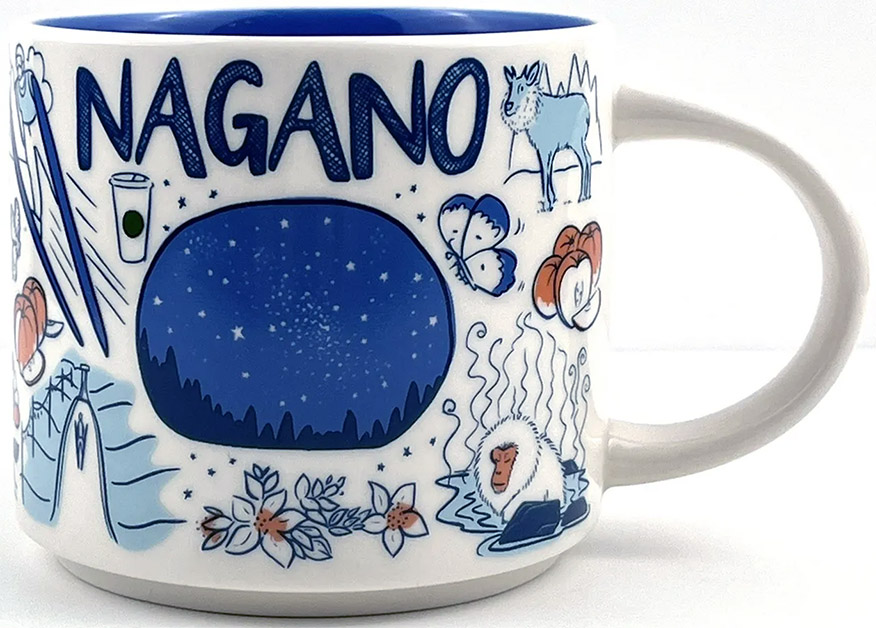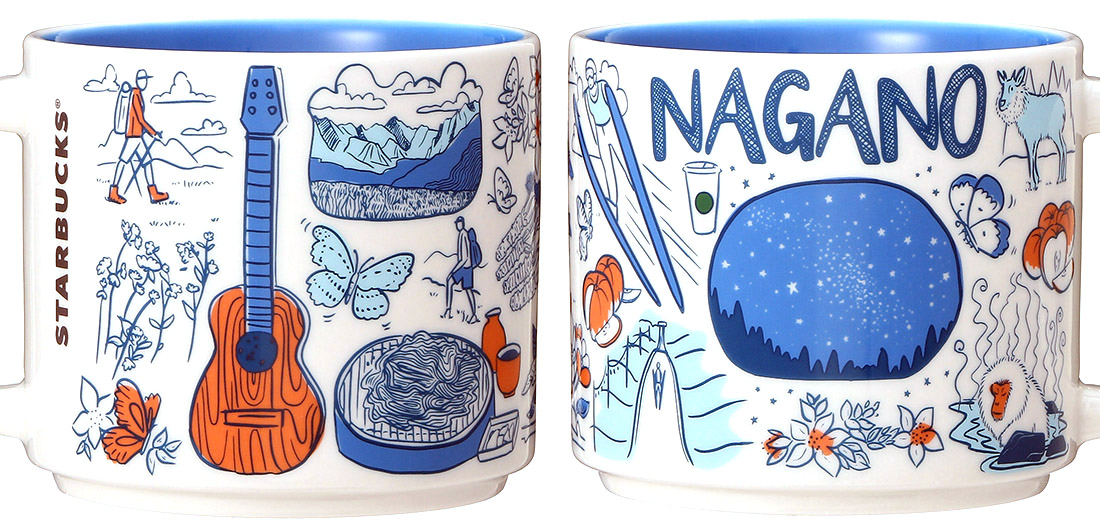
Been There – Nagano
Starbucks Been There – Nagano is a mug for a prefecture located in the Chūbu region of Japan. Originally settled in prehistoric times, Nagano played a significant role during the Sengoku period (1467-1615) as a strategic location for several prominent feudal lords. The area’s historical prominence was further highlighted by the construction of the famous Zenko-ji Temple in the 7th century, which became a major pilgrimage site. During the Edo period (1603-1868), Nagano thrived as a post town on the Nakasendo route, connecting Edo (modern-day Tokyo) with Kyoto. The arrival of the railway in the late 19th century spurred modernization and economic growth. In contemporary history, Nagano gained international recognition by hosting the 1998 Winter Olympics, showcasing its natural beauty and revitalizing its cultural heritage.
Symbols and landmarks from the design of the Starbucks Been There Nagano mug:
– Jigokudani Monkey Park is famous for its hot springs and the wild Japanese macaques, commonly known as snow monkeys, that frequent the area. Located in the Yokoyu River valley, the park offers a unique opportunity to observe these monkeys bathing in natural hot springs, especially during the winter months when the area is blanketed in snow. Established in 1964, the park provides a rare chance to see these primates up close in their natural habitat. The sight of snow-covered monkeys relaxing in steaming hot springs has become an iconic image of Nagano, drawing wildlife enthusiasts and photographers from around the world.
– The Kiso Valley, part of the old Nakasendo Trail, offers a glimpse into Japan’s feudal past with its well-preserved post towns, such as Magome and Tsumago. The Nakasendo Trail was one of the five routes of the Edo period, linking Kyoto to Edo (now Tokyo), and was frequented by samurai, merchants, and travelers. Walking along this historic trail allows visitors to experience traditional Japanese hospitality at local inns, savor regional cuisine, and appreciate the scenic beauty of the lush valley and mountains. The meticulous preservation efforts in the Kiso Valley ensure that the charm and authenticity of the Edo period are retained, making it a popular destination for history buffs and nature lovers alike.
– Nagano gained international fame as the host of the 1998 Winter Olympics, an event that left a lasting legacy on the region. The prefecture boasts numerous world-class ski resorts, such as Hakuba Valley and Nozawa Onsen, attracting winter sports enthusiasts from all over the globe. The Olympic venues, including the M-Wave speed skating arena and the Hakuba ski jumps, are still in use today and serve as training grounds for athletes. The successful hosting of the Winter Olympics not only boosted Nagano’s global profile but also significantly enhanced its tourism infrastructure, making it a premier destination for winter sports and recreation.
– Nagano is known for the production of acoustic guitars. The city of Matsumoto in particular, has been home to several guitar manufacturers, including Matsumoku, Fujigen, and Atlansia. These companies have produced a range of acoustic guitars, including classical guitars, small steel-stringed acoustic guitars, and high-quality acoustics. Nagano’s guitar manufacturers have contributed to the Japanese guitar industry’s reputation for producing quality instruments.
Not listed in the design, but nevertheless places that are worth visiting when in Nagano:
– Zenko-ji Temple, one of the most significant and historical temples in Japan, dates back to the 7th century. It is renowned for housing the first Buddha statue ever brought to Japan, a hidden treasure that is rarely shown to the public. The temple is a major pilgrimage site, attracting millions of visitors annually who come to seek spiritual solace and partake in the Okaidan Meguri, a pitch-dark passage symbolizing a journey to enlightenment. Zenko-ji’s annual Gokaicho festival, held every six years, is a grand event where the hidden Buddha is revealed, drawing huge crowds from across the country.
– Matsumoto Castle, also known as “Crow Castle” due to its black exterior, is one of Japan’s most beautiful and well-preserved original castles. Constructed in the late 16th century, it is a prime example of a hirajiro, or a flatland castle, built on a plain rather than a hill or mountain. The castle’s wooden interiors and external stone walls remain largely intact, offering visitors a genuine glimpse into the architectural and defensive techniques of the time. Surrounded by a moat and set against the backdrop of the Japanese Alps, Matsumoto Castle is particularly stunning during the cherry blossom season in spring and the vibrant foliage of autumn.























































































